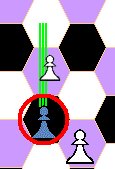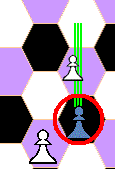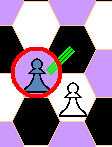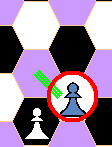The rules are very similar to those of orthodox chess, adapting the movements to the hexagonal board (a hextilled chequerboard). It is also true that there are some differences and new pieces, but this summary briefly synthesizes the movements on the hexagonal board, the new elements, and other specific differences.
Hexagonal chess was invented by Władysław Gliński in 1936, although it uses a smaller board and the rules are somewhat different from those of C'escacs. It was very popular in the 1970s and 1980s in the UK and Poland.
Initial setup
The board forms a regular hexagon with eight hexes on each side, and has three different colours: white, black and coloured, with the central hex coloured.
The white king and queen take positions in white hexes, and the black king and queen take positions in black hexes. The kings are positioned opposite each other, on the G column: the white king on his right, and the black king on his left.
The pieces
Relative Value
| Piece | Valor |
|---|---|
Pawn

|
1 |
Elephant

|
2 |
Bishop

|
3 |
Knight

|
4 |
Pegasus

|
8 |
Rook

|
10 |
Wyvern (Dragon)

|
15 |
Queen

|
16 |
First impressions
-
It is a large board with 169 hexes. They come in three different colours, and three bishops are required.
-
The power of the bishop decreases markedly compared to orthodox chess.
-
-
It incorporates the Wyvern (Dragon), which combines the moves of the Rook and Knight, and two Pegasus, which combine the moves of the Bishop and Knight.
-
It increases the mobility of the pawns, but, even so, their power decreases compared to orthodox chess.
-
The loss of pawn power is due to the inefficiency of pawn structures in hexagonal chess.
-
The Elephant piece is incorporated to support the pawn structures.
-
-
Initially the pieces are protected, with the exception of the two rooks and the two flank pawns.
Movements: orthogonal, diagonal and knight moves
File: orthogonal direction

A line which exits one hex and enters another by crossing a common border. Orthogonal moves are never colourbound, as adjacent hexes are of different colour.
Each hex belongs to three different files: A lengthwise file (referred to as column) and two oblique files. There are six different orthogonal directions, two on each file.
The orthogonal directions are the directions of the rook moves.
Line: diagonal direction

A line which exits one hex and enters another by following the line which connects their nearest corners.
All the hexes on the same line are the same color, so, diagonal moves are always colourbound, but unlike the square board, the vertices of the hexes of a line do not touch.
Each hexe belongs to three diferent lines, each one crossing in a stright line the hex at two of its corners: two oblique lines and one transversal line (referred to as cross-line). There are six different directions, two on each line.
Diagonal directions are the directions of the bishop moves; there are three different colors, so, there are three bishops, one for each color.
Knight jump



- Knight jump is the combination of one diagonal hex move and one orthogonal hex move; each diagonal direction allows two orthogonal diferent final positions; there are a total of twelve legal moves.
- A knight jump can't be prevented positioning a piece in the path of the knight; it is said that
knight
jumps
. - The color of the destination hex always is different from color of the hex where the move is originated.
- The knight jump can be made by the following pieces: Knight, Pegasus and the Wivern (Dragon).
Ride 
The intermediate hexes, which must be empty to move, are shown.
- C'escacs ride move is a doble knight jump (only twice), without capture.
- The second jump must be done just the same way as the first one: same diagonal direction and same orthogonal direction. So, it is defined by the initial jump; there is only one possible ride for each knight move.
- The destination hex must be free, as it this move doesn't allow capturing opponent pieces.
- The intermediate hex chaining both jumps must also be free.
- The color of the destination hex always is different from color of the hex where the move is originated.
- The Ride move can only be done by the Knight.
Piece movements
-
Rook

Orthogonal movement: toward six orthogonal direccions, on files.
-
Bishop

Diagonal movement: toward six diagonal directions, on lines.
Colour bound; it's a weak piece in hexagonal chess, remarkably weaker than the knight.
-
Knight

There are two different movements:
- Knight jump, as described; there are twelve possible ones.
- Knight ride, as described:
- Two equal knight jumps are chained; There are twelve possible ride moves, one for each simple knight move.
- The intermediate hex, as for the simple jump move, must be free.
- He cannot capture pieces when moving by riding; the final hex has to be empty.
There are twenty four total possible moves, but only the twelve simple knight moves allow a capture. The color of the destination hex always changes with respect to the color of the source hex, both in single movements and in double movements while riding.
-
Pegasus

The winged horse can move diagonally, along the lines as a bishop, or make a knight jump.
He can't ride, as the knight ride.
He combines the movements of the bishop and the knight (without the knight ride).
In hexagonal chess its power is less than a rook, and it is considered a median piece, superior to the minor pieces, but without reaching the power of the major pieces.
-
Wyvern (Dragon)

The dragon can move orthogonally, along the files, or make a knight jump.
He can't ride, as the knight ride.
He combines the movements of the rook and the knight (without the knight ride).
It's power is similar to that of the queen.
-
Queen

Movement in the six orthogonal directions and in the six diagonals; move through both files and lines.
She combines the movements of the rook and the bishop.
-
Elephant

The movement of elephants is as in eastern chess (Sittuyin, ASEAN-Chess...): in diagonal directions forward or backward, or advancing one or two hexes; a total of six different hexes.
He cannot move diagonally to the sides, and orthogonally only forward. In all there are six hexes; the movements of the elephant draw the four legs and the trunk.
It is a very slow piece, which allows the construction of consistent structures of pawns, and its power can be said to be considerably less than that of a bishop, but it is true that it is mainly due to its slowness and little maneuverability; its function is to support pawn structures.
Elephant moves -
Pawn

The pawn's moves are different if it captures or makes a move to an empty hex; In addition, there are specific movements for some situations.
Pawn moves  Moves without capture
Moves without capture
- The pawn may move forward one or two hexes; double step is allowed anywhere.
- The pawn may also move one hex orthogonally oblique, to either of the two adjacent oblique forward hexes by 60º.
- In total it has a maximum of four non-capture moves, not counting the possible additional initial move.
 Capture moves
Capture moves
- To capture the pawn moves diagonally towards either of the two diagonally forward hexes, following the two lines at 30º, that is, in the two front hexes of the same color as the hex it is in.
 Special moves
Special moves
Initial move
In the initial positions, the pawns can make a triple forward movement along the column, with the exception of the central column (on the 'F' column) and both columns on the flanks (the 'A' column and the 'L' column).
A pawn may have been moved, but remain in one of these initial eight hexes. In this case, it will keep the ability to do the triple move.
That is to say: for each player there are eight positions from which a pawn can make a triple move, and three pawns that can never make a triple move.
 Special moves
Special moves
Promotion
When a pawn reaches one of the fifteen hexcaques on the opponent's side, it will necessarily promote, but the piece he promotes must be a regainable piece previously captured.
-
Regainable pieces are: Queen, Wyvern (Dragon), Rooks, Pegasus, Knights and Bishops, but the colour of the Bishop must be taken into account, as you cannot have two Bishops of the same colour in play; only a Bishop of the same colour that has been captured is regainable.
Elephants are not regainable.
 Special moves
Special moves
Forced promotion
Pawn awaiting promotion
It seems unlikely that there are no captured regainable pieces available to promote a pawn, but if this were the case, the pawn would remain unpromoted, with its moves limited by its board position, until either the opponent captures a valid piece for promotion, or the pawn itself is captured. It is called a pawn awaiting promotion.
On the turn of the player with a pawn awaiting promotion, immediately after being captured one of his regainable pieces valid for the promotion, and if he is not in check, the move will necessarily consist of promoting the pawn that had been awaiting promotion, without making any other move.
If the player is in check, the promotion move must be made on the first move in which the player is not in check, without making any other move.
 Special captures
Special captures
En passant capture


En passant capture Initial position - A pawn that makes a double or triple move and passes through a hex in which it could have been captured by an opponent's pawn, it can also be captured.
- The en passant capture must be done immediately after the double or triple movement.
- The pawn that makes the capture is positioned in the hex where it would have made a normal capture, and the opponent's pawn removed from the game, ignoring the position it has advanced to (one or two hexes ahead).
 Special captures
Special captures
Capture of the scornful pawn


Capture of the scornful pawn Initial position When two pawns from opposite sides are facing each other, they do not hold, because in C'escacs the pawns can move obliquely.
But if a pawn facing another opponent despises the position and makes a sideways move to dodge it, it can be orthogonally captured by the opponent's pawn that it scorned and tried to dodge.
- When a pawn faced with an opponent's pawn, in the same column and consecutive hexes, makes an oblique movement avoiding the opponent's pawn, it can be orthogonally captured.
- The capture move must be made immediately after the pawn's scornful move.
- The capture is made orthogonally, moving to the position where the opponent's pawn is. It is the only capture with an orthogonal move that a pawn can make.
A case can arise when a pawn is promoted by making a scornful move avoiding the opponent's pawn which it was facing. This case can only occur on the T, A, L, X columns, after making a scornful move respectively from the A, B, K, L columns. The capture of the scornful pawn also applies in this case, and the piece to which the pawn has promoted will be captured.
Also on the T, A, L, X columns an en passant capture can be given at the moment of promotion; not on the other columns, as they cannot have pawns so far behind. In this case, too, the piece to which the pawn has been promoted is captured.
-
King

He can move a single hex orthogonally or diagonally; in total twelve possible movements.
- You cannot make a move that leaves the king threatened (in check)
- When he is threatened (in check) he has to be moved, or you have to move another piece which avoids the check.
- If there is no move to avoid the check, it is checkmate, and the game is lost.
 King's leap
Initial move
King's leap
Initial move
The five diferent hexes for the King as a result of such leap. The King can make a leap on its first move, a knight jump:
- When the King has not yet been moved.
- When the King is not threatened (in check).
- A capture can be done on this move.
- As it stands on the last rule, it can't be used to capture a piece which is theatening him (check).
You can see the rules of the King's Leap in more detail in a specific section available on another page of this website.
 Castling
Initial move
Castling
Initial moveCastling exists in C'escacs, but it is not a fundamental move to develop the strategy, and it is convenient to play the first games obviating this rule, as detailed below. In the Castling section of this website, separate on another page, the two variants are detailed: the single castling, with one Rook, and the double castling, using both of them.
- Not to be confused with the King's leap.
- It is also an evasive move, but allows you to incorporate defense with the Rook.
Play without Castling
Recommendation for first games- It is recommended to play without Castling to get started in the game.
- Must be agreed at the beginning of the game.
- If played without Castling, the King's Leap will remain, but without allowing the King to capture with this move.
Rules
Draw
A draw, or a tie between the two contestants, in a tournament represents 1 point for each player, and occurs:
- By mutual agreement between the opponents, or if the players have no pawns and the material is insufficient to checkmate the opponent.
- When the same
position is repeated five times, not necessarily consecutively.
The case of perpetual
check generally falls under this assumption.
A player can demand a draw if the same position is repeated three times.
- By exhaustion
of moves: After 75 consecutive half-moves by each player (seventy-five
full-moves)
without any captures or pawn moves.
A player can demand a draw if there are 50 consecutive moves moves without any captures or pawn moves.
Draw and the stalemate win
Stalemate is not draw in C'escacs, but a win by the slightest. So, in chess tournament:
- Victory awards 3 points to the winner.
- Draw award 1 point for each player.
- A player who stalemates the other player will get 2 points, and the player left without legal moves, 1 point.
However, stalemate is a very strange case in C'escacs.
General rules
Touch-move
- A player, having the move, who deliberately touches a piece on the board must move or capture that piece if it is legal to do so.
- A player who lets go of a piece after making a legal move cannot retract the move, but an invalid or illegal move has to be rectified immediately.
- Conditions that cause a player to lose the game:
- Disarranges the position of the playing pieces on the board.
- It does not agree to resume an interrupted game within a reasonable time.
- When a watch is used and exceeds the time.
- When it fails to comply with a legal requirement of the opponent.
- Refuses to abide by the rules.
Endgames
- The King and a Pawn against a lone King ends up promoting the Pawn, provided its King is close enough to defend it.
- The King with a major piece (Queen, Wyvern or Rook) can checkmate a lone King.
- In an endgame, when
all the pawns have already been captured and one opponent has only the
King left,
and the other has no
major pieces:
- You need at least the King with a median piece (Pegasus) and a minor piece (Knight or Bishop) to mate a lone King.
- If the player with the most material has only the lone
King,
or the King
with a minor
piece, or the King with an
Elephant,
Mate is not possible.
The player is said to have
insufficient material
, and the game is drawn. - If the player with the most material
has only the King with one
median piece
(Pegasus), or the
King with two
minor pieces,
or the King with one
minor piece and an
Elephant, or
when the King has only
Elephants,
there are only rare positions in which mate is possible, but with these pieces it is not possible
to move the King into a mate position.
- If the position does not allow a glimpse of mate in five moves, it would also be a case of
insufficient material
, but it will be treated as a draw by agreement, or, if the players do not agree, it will be a draw for exhaustion of moves, applying the fifty-move rule (one hundred half-moves), or the seventy-five-move rule (one hundred and fifty half-moves).
- If the position does not allow a glimpse of mate in five moves, it would also be a case of
Additional information on endings
- A King and a Rook beat a King and a Bishop or a King and a Knight.
- The King and a Queen beat a King and a Pegasus.
- The Wyvern (Dragon) and the Queen have approximately the same power. The Queen is preferable against the Pegasus, but the Wyvern (Dragon) is much better against the Rook.
- The King and a Queen do not beat a King with a Rook.
